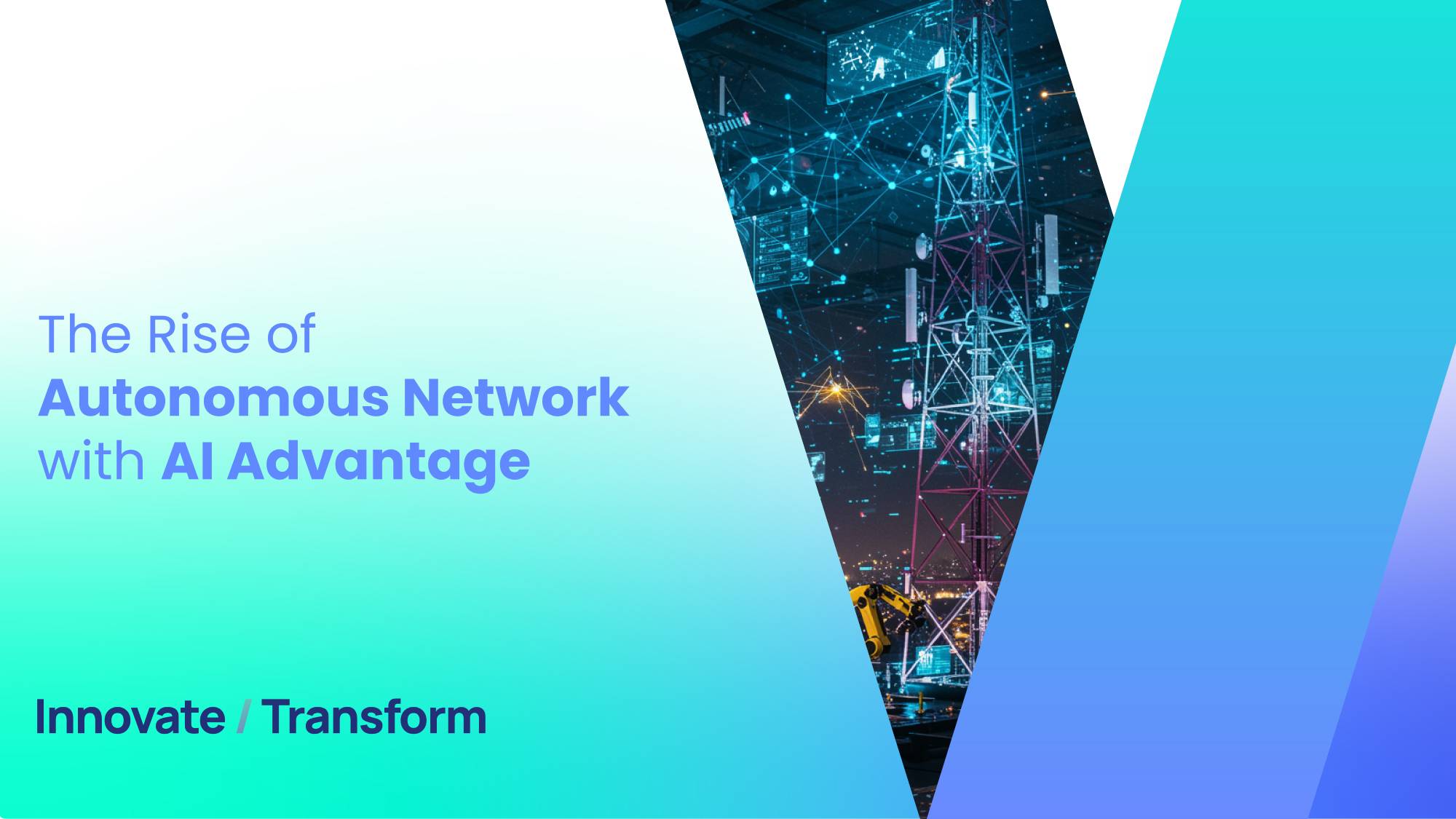
In today’s highly connected digital landscape, telecom networks are becoming more intricate due to the rapid adoption of 5G, the expansion of edge computing, and the surge in IoT devices. Managing such complexity with manual or semi-automated tools is increasingly unsustainable. This has led to the emergence of Autonomous Networks—intelligent systems capable of sensing, analyzing, deciding, and acting independently. These networks enable zero-touch operations, enhanced agility, self-healing capabilities, and significantly improved efficiency.
As telecom providers look ahead to 6G, network autonomy is no longer a future ambition—it is a necessary transformation.
What Are Autonomous Networks?
Autonomous networks are infrastructures designed to operate with minimal human input, thanks to deep integration with AI and machine learning. These systems continually observe their environments, detect issues, adapt to real-time changes, and optimize performance on their own. Their primary characteristics include:
- Self-configuration: Automatically adapting system settings to meet requirements
- Self-monitoring: Continuously tracking performance metrics and operational health
- Self-healing: Identifying and correcting faults with minimal disruption
- Self-optimization: Dynamically fine-tuning performance based on network demand
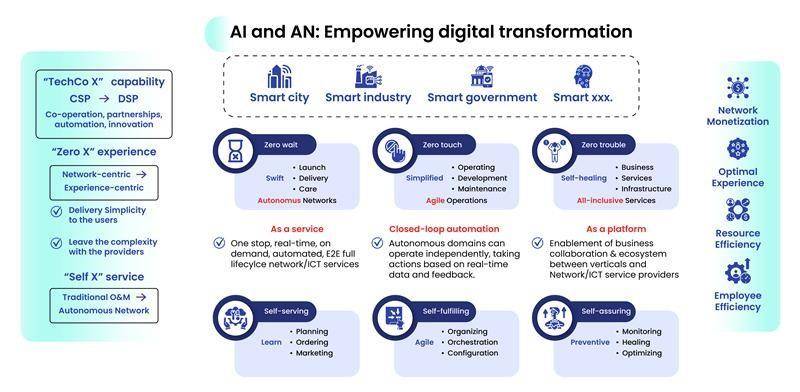
According to TM Forum’s Autonomous Network Maturity Model, there are five progressive levels of autonomy. As networks scale and expectations rise, progressing through these levels becomes essential to meet the demands of 5G and 6G.
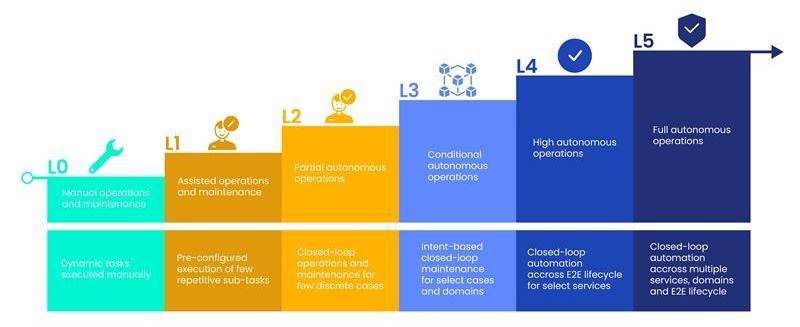
Why Is Autonomy Critical Now?
Several pivotal developments are accelerating the shift toward autonomous networks:
- Increased Network Complexity: The move to virtualized, disaggregated, and distributed infrastructures presents new operational challenges.
- Cost Efficiency Demands: Manually managing large-scale, heterogeneous networks is resource-intensive and error-prone.
- Real-Time Service Expectations: Consumers and industries now demand ultra-low latency, high throughput, and uninterrupted service.
- Advances in AI/ML: Modern algorithms are now robust enough for real-time, large-scale deployment in live telecom environments.
- Data Explosion: Growing volumes of telemetry data require intelligent systems for timely and actionable insights.
Architecture of Autonomous Networks
Achieving network autonomy involves designing modular systems where data collection, AI-based analytics, and decision engines work seamlessly together. The architecture includes the following key layers:
1. Data & Telemetry Layer
This layer forms the foundation of autonomous networks, collecting real-time data from RAN components, routers, OSS/BSS systems, sensors, and user applications. Its responsibilities include:
- Protocol Management: Using standards like gRPC and SNMP traps for data exchange
- Data Enrichment: Enhancing raw data through correlation, normalization, and geo-tagging
- Data Quality Assurance: Ensuring integrity via deduplication, validation, and traceability
Example snippet:
if signal_strength < -95:
status = “weak_signal”
else:
status = “nominal”
This enriched, high-quality data is then processed by AI/ML engines to extract insights and enable automation.
2. AI/ML Intelligence Layer
This layer serves as the brain of the autonomous system. It applies machine learning and AI to interpret data and guide actions:
- Anomaly Detection: Leveraging models like Isolation Forests or autoencoders to identify outliers
- Traffic Forecasting: Using time-series methods (LSTMs, ARIMA, Prophet) to anticipate demand
- Root Cause Analysis: Employing Graph Neural Networks or decision trees to identify issues
- Intent Classification: Translating business goals into network behavior using NLP
These models are deployed through orchestration tools such as MLflow and Kubeflow, with continuous monitoring to detect performance drift or anomalies.
3. Intent-Based Policy Engine
Intent-based networking allows operators to specify desired outcomes, while the network determines the best implementation strategy.
- Converts service-level intentions (e.g., “ensure latency < 20ms for gaming”) into enforceable configurations
- Uses advanced language models, semantic parsing, and DSLs (Domain-Specific Languages)
The policy engine ensures there are no conflicts and dynamically adapts to real-time changes in demand or conditions.
4. Closed-Loop Automation
Closed-loop automation enables the network to self-regulate using the Observe–Orient–Decide–Act (OODA) framework:
- Observe: Continuously gather metrics and alerts from the network
- Orient: Analyze data with context from historical and AI models
- Decide: Choose the optimal action based on insights
- Act: Execute changes through orchestration layers or APIs
Sample logic:
if throughput > max_threshold:
reroute(path=”secondary_route”)
trigger_alarm(event_id)
5. Edge AI and Localized Decision-Making
Autonomy must extend to the edge of the network to meet latency-sensitive needs:
- TinyML: Lightweight models for local anomaly detection on edge devices
- Edge Inference Engines: Tools like TensorRT, OpenVINO, TensorFlow Lite for real-time analytics for deploying and accelerate AI inference on various GPUs for Intel, NVDIA etc.
- MEC Integration: Deploying AI directly at base stations for immediate RAN optimization
This distributed intelligence reduces latency, avoids congestion, and supports real-time action.
Open-Source Foundations of Autonomous Networks
Open-source frameworks and componentized architectures play a critical role in enabling scalable and cost-effective autonomy. In particular, Open RAN (O-RAN) facilitates automation by integrating AI into disaggregated RAN systems.
Open RAN Interfaces and Functions
O-RAN breaks down RAN components and introduces standard interfaces:
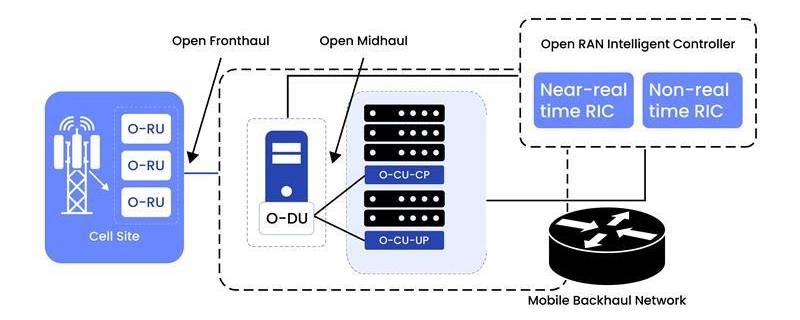
Phone → Antenna (RU) → Fronthaul → DU → Midhaul → CU → Backhaul → Core Network → Internet
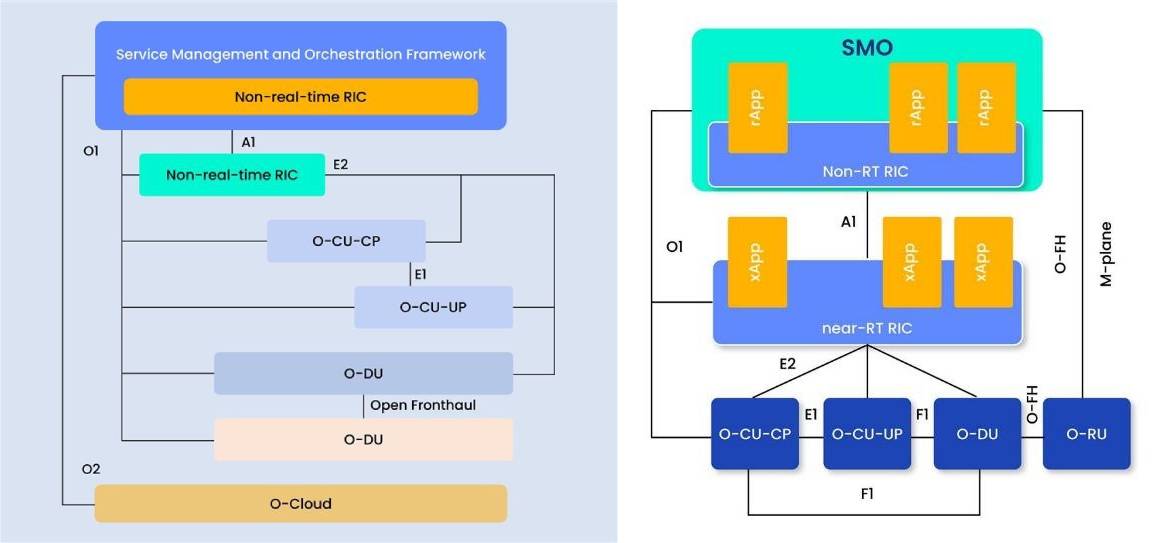
| Interface | Connects | Purpose |
| FH (Fronthaul) | ODU 🡨🡪 ORU | Transfers control/data streams and sync; typically eCPRI-based |
| F1C / F1U | OCU (CP/UP) ODU | Handles controlplane (F1C) and userplane (F1U) separation |
| E1 | OCUCP 🡨🡪 OCUUP | Coordination between control and user plane within CU |
| E2 | NearRT RIC 🡨🡪 (OCU, ODU, ORU) | Realtime monitoring, control actions via xApps |
| A1 | NonRT RIC 🡨🡪NearRT RIC | Policy management, ML model transfer |
| O1 | SMO / NonRT RIC 🡨🡪 OCU / ODU / ORU | Operational management, FCAPS, software upgrades |
| O2 | SMO 🡨🡪 OCloud | Manages cloud resources and container orchestration |
Key Open RAN Components:
| Component | Description | Open Source Projects |
| RU (Radio Unit) | Handles RF transmission and reception | Vendor-specific hardware (compliant) |
| DU (Distributed Unit) | Processes real-time L1/L2 functions | OAI DU, FlexRAN |
| CU (Centralized Unit) | Handles higher-layer protocols (L3, PDCP) | OpenAirInterface CU, O-RAN SC |
| RIC (RAN Intelligent Controller) | Executes xApps (near-RT) and rApps (non-RT) for AI-based RAN control | O-RAN SC (RIC Platform), E2 Manager |
| SMO (Service Management and Orchestration) | Manages RAN lifecycle | ONAP, Open RAN SMO |
| xApps | xApps are lightweight applications deployed on the Near-RT RIC. They respond quickly to events in the network and interact directly with DU/CU elements through the E2 interface. | Nokia’s RIC SDK, VMware, Mavenir & Custom Apps |
| rApps | rApps are deployed in the Non-RT RIC within the SMO (Service Management and Orchestration) layer. They focus on longer-term strategies, AI/ML model training, policy generation, and performance analytics. | Nokia’s RIC SDK, VMware, Mavenir & Custom Apps |
The ORAN architecture disaggregates RAN functions (RU, DU, CU) and connects them through standardized, open interfaces (FH, F1, E1, E2, A1, O1, O2). It integrates both near-RT and nonRT RICs to provide intelligence and automation—transforming RAN into a flexible, scalable, and multi-vendor ecosystem.
Key AI-Enabled Use Cases in Open RAN
Open RAN disaggregates the traditional RAN into modular components (RU, DU, CU) and introduces open interfaces. This openness enables AI/ML integration at various layers of the network to support:
Automation of network operations
- Real-time performance optimization
- Energy efficiency improvements
- Advanced anomaly detection and security
| Use Case | AI/ML Application | Benefits |
| 1. RAN Intelligent Controller (RIC) | Near-Real-Time (near-RT) and Non-Real-Time (non-RT) RICs use AI to manage resources dynamically | Optimal spectrum usage, QoS assurance |
| 2. Self-Organizing Networks (SON) | AI learns traffic patterns and adjusts configurations | Reduces manual tuning, improves KPIs |
| 3. Predictive Maintenance | AI detects early signs of equipment failure | Avoids downtime, reduces OPEX |
| 4. Energy Efficiency | AI powers sleep mode algorithms for radios and network elements | Reduced energy consumption |
| 5. Interference Management | AI models predict and mitigate cross-cell interference | Better spectral efficiency |
| 6. Traffic Steering & Load Balancing | AI redistributes users across cells during peak traffic | Improved user experience |
| 7. Anomaly Detection & Security | AI identifies unusual behavior or intrusions in control/signaling | Enhanced network security |
RIC enables closed-loop automation at the edge using xApps.
Open Core Network
Autonomous capabilities extend into the 5G Core as well, leveraging cloud-native, service-based architecture (SBA) with open-source implementations.
Key Core Functions (NFs):
| Core Network Function (NF) | Description | Open Source Projects |
| AUSF | AUSF is the 5G network function responsible for authenticating subscribers (UEs – User Equipment) when they attempt to access the network. | Free5GC |
| AMF (Access & Mobility Mgmt) | UE connection and mobility | Free5GC, Open5GS |
| SMF (Session Mgmt) | IP session establishment, QoS | Open5GS, OpenAirInterface |
| UPF (User Plane Function) | Packet routing and forwarding | BESS/DPDK-based UPFs, Free5GC |
| PCF (Policy Control) | SLA and service policy enforcement | Free5GC, Open Policy Agent integration |
| UDM/UDR | User data management and storage | Free5GC |
| NEF | Exposes network capabilities to apps | Under development in Free5GC roadmap |
| UDM | UDM is the central data management function in 5GC, managing user subscription profiles, authentication credentials, and policy data. |
Supporting Infrastructure:
- Service Mesh: Istio or Linkerd for secure service-to-service communication.
- Orchestration: ONAP(open Network Automation Platform), Nephio (K8s-based), or OpenShift GitOps
- Telemetry: Prometheus, Grafana, Fluentd (Collect, transform & forward logs), Jaeger (Distributed Tracing)
- SDN/NFV: OpenDaylight (SDN), OPNFV (VNFs/CNFs), Tungsten Fabric (vRouter)
- Kubernetes: Platform for NF containerization and scaling
- CI/CD Pipelines: Jenkins, ArgoCD for continuous deployment of new policies, xApps, ML models
End-to-End Closed Loop with Open Source Stack
An integrated example:
- Telecom data ingested via Prometheus from the Open RAN DU
- AI model detects QoE degradation (e.g., drop in SINR)
- Decision sent via A1 interface to the RIC xApp
- xApp triggers optimization (e.g., power adjustment, handover) via
E2 interface
- 5. KPIs updated → loop restarts → SLA maintained autonomously
# Closed loop in Open RAN
if sinr < 10:
suggest_cell_switch(user_id)
How Autonomous Networks Handle Key Performance Indicators (KPIs)
A truly autonomous network not only observes but acts on real-time KPI deviations. Critical radio and transport-level metrics such as RSRP (Reference Signal Received Power), RSRQ (Reference Signal Received Quality), SINR (Signal-to-Interference-plus-Noise Ratio), latency, and throughput are continuously monitored, predicted, and optimized.
Some of the KPIs are mentioned below for reference.
| KPI | Description | How Autonomy Handles It |
| RSRP | Measures received signal strength | AI models forecast RSRP trends → Predict coverage holes → Trigger antenna tilt or beamforming adjustments |
| RSRQ | Indicates quality of the signal | ML detects degradation in signal quality → Reallocates resources or triggers handovers |
| SINR | Quality of signal vs interference/noise | Anomaly detection flags interference sources → System adapts transmission power or selects alternate cells |
| Latency | Delay in data transmission | Policy engine sets low-latency paths → Edge processing triggers rerouting based on congestion prediction |
| Throughput | Amount of data transferred over time | Forecasting models anticipate peak loads → Dynamically scale network slices or optimize scheduling algorithms |
Sample logic:
if rsrp < -110:
trigger_beam_recalibration()
elif rsrq < -15:
initiate_handover_to_neighbor_cell()
Closed-Loop Automation: The Engine of Autonomy
At the heart of autonomous networks lies Closed-Loop Automation (CLA)—a continuous process where the network:
- Observes: Ingests real-time telemetry and KPI data
- Analyzes: Applies AI/ML models to detect patterns, deviations, or predict events
- Decides: Uses policy engines or reinforcement learning to select optimal actions
- Acts: Executes decisions automatically via orchestrators, SDN controllers, or edge agents
This creates a self-sustaining feedback loop—one that evolves over time based on outcomes and learning.
Types of Closed Loops
- Fast Loops (Edge): Microsecond-level responses (e.g., beam realignment)
- Near-Real-Time Loops: Millisecond to second-level (e.g., traffic rerouting, slice scaling)
- Slow Loops (Core/Policy): Periodic optimization (e.g., model re-training, capacity planning)
Use Cases for Autonomous Networks
- a) Self-Healing Networks
- ML detects degrading link conditions before failure
- Closed-loop triggers function migration to healthy nodes
- b) Self-Optimizing Networks (SON)
- Dynamic RAN parameter tuning based on traffic patterns
- Improved QoE and efficient spectrum usage
- c) AI-Augmented NOC
- Predictive alarms replace reactive alerts
- AI agents categorize and route incidents automatically
- d) Network Slicing Autonomy
- Real-time slice provisioning and scaling based on user demand and SLA requirements
- e) Digital Twins
- Live simulation environments reflect current network state
- Safe testing of policy or architectural changes
Challenges and Mitigation Strategies
| Challenge | Solution |
| Model Drift | Online learning, model retraining pipelines |
| Policy Conflicts | Conflict resolution frameworks |
| Siloed Data Sources | Unified data fabric, schema enforcement |
| Lack of Trust in AI | Explainable AI (SHAP, LIME), governance |
| Legacy Systems | API wrappers, phased modernization |
Analytics: The Brain of Autonomy
From my perspective as Head of Analytics, autonomy is a data-centric transformation.
- Real-time pipelines drive instant responses
- Predictive analytics feed into closed-loop actions
- Explainability ensures network decisions are auditable and trustworthy
- Observability platforms like Grafana and Prometheus ensure we don’t operate in the dark
A modern analytics stack for autonomy includes:
- Kafka, Flink for stream processing
- Feature Stores for ML model inputs
- ModelOps Tools for lifecycle management
- Data Governance Frameworks for auditability
6G and the Future of Autonomous Networks
The next evolution 6G will elevate autonomy to cognitive levels:
- Generative AI will enable intent synthesis and dynamic policy generation
- Quantum AI for real-time network optimization
- Swarm Intelligence for decentralized decision-making at scale
- Blockchain for distributed trust, SLA enforcement, and federated orchestration
Networks will no longer be just programmable—they will be self-aware, adaptive, and anticipatory.
Conclusion: Are You Ready for the Shift?
Autonomous networks are not just about automation—they represent a paradigm shift in how networks are designed, managed, and experienced and to be used as a Service. From predictive operations to intent-driven service delivery, the benefits are tangible: reduced OPEX, faster time-to-market, superior resilience, and next-level customer experience.
The building blocks—data platforms, AI models, orchestrators—are here. What’s needed now is vision and execution.
The question is no longer if you’ll adopt autonomy. The question is how fast you can scale it.
Are you working on autonomous network initiatives or planning to? Let’s connect. Reach out to share ideas, collaborate on solutions, or explore use cases together. Comment, share, and let’s build networks that think, adapt, and evolve.

